The Study in Brief
• Work integrated learning (WIL) is associated with easing graduates’ transition into the labour market, as measured by employment outcomes such as income, employment status, or whether the occupation matches the student’s field of study. This report analyses newly available data to provide insights into the success of different types of WIL (e.g., co-op programs and paid and unpaid work placements) and provides new estimates of the returns to WIL in Canadian postsecondary education (PSE).
• The results show that WIL programs are associated with improved labour market outcomes but the benefits differ by program type, gender, field of study, educational institution and other factors. For example: participating in a co-op program is associated with larger benefits for men than for women. Conversely, participating in a work placement after classes end is associated with larger benefits for women than for men, particularly at the college level.
• Governments spend millions of dollars supporting WIL programs through tax credits, subsidies and direct funding. Insights about the different benefits to graduates entering the job market are important to ensuring that WIL programs are consistently refined as they are expanded and that the case for government subsidization is evidence-based.
Introduction and Overview
The transition from education to the labour market is an important milestone for young people in Canada. Ensuring their smooth transition to the labour market is critical for individual success and overall economic prosperity. Work-integrated learning (WIL) – programs of study that integrate academic and workplace experiences – has been identified by provincial and federal governments as a key part of the strategy to prepare post-secondary graduates for transition to the labour market
This Commentary aims to enhance our understanding of the relationship between WIL participation and labour market outcomes of graduates in terms of income, employment status and occupation matching well with education. A deeper understanding of the mechanisms affecting graduates’ labour market outcomes can inform policy and program guidance. To help advance this comprehension, we rely on the 2018 National Graduates Survey (NGS) and analysis from Pizarro Milian et al. (2021).
Overall, our analysis shows many benefits associated with WIL participation, but also an uneven distribution of benefits across WIL programs and educational institutions. Benefits associated with WIL participation include improved job matching, higher incomes and higher likelihood of being employed in a permanent and/or full-time position. In particular, more benefits are associated with co-op participation than with work placements, and those benefits are more pronounced at the university, rather than college, level. Work placements, however, are more beneficial for women, while men gain more from co-op participation.
The mechanisms underlying these differences would be a promising area for further study.
To cite this document: Wyonch, Rosalie, and Bradley Seward. 2023. From Class to Career: How Work Integrated Learning Benefits Graduates Looking for Jobs. Commentary 642. Toronto: C.D. Howe Institute.
C.D. Howe Institute Commentary© is a periodic analysis of, and commentary on, current public policy issues. Barry Norris and James Fleming edited the manuscript; Yang Zhao prepared it for publication. As with all Institute publications, the views expressed here are those of the authors and do not necessarily reflect the opinions of the Institute’s members or Board of Directors. Quotation with appropriate credit is permissible.
To order this publication please contact: the C.D. Howe Institute, 67 Yonge St., Suite 300, Toronto, Ontario M5E 1J8. The full text of this publication is also available on the Institute’s website at www.cdhowe.org.
The authors thank Parisa Mahboubi, Benjamin Dachis, Jeremy Kronick, Nobina Robinson and Mikal Skuterud for helpful comments on an earlier draft. The authors retain responsibility for any errors and the views expressed.
Evidence of the Benefits of Work-Integrated Learning
Studies have shown that graduating from a WIL program is generally associated with beneficial outcomes in the labour market. Results vary significantly between college and university graduates, across fields of study and by demographic characteristics. For example, co-op participation reduced the likelihood of over-qualification (Frenette 2004), increased the likelihood of full-time employment and was associated with higher employment incomes (Walters and Zarifa 2008) for university graduates, with relatively lower or insignificant benefits for college graduates in both studies.
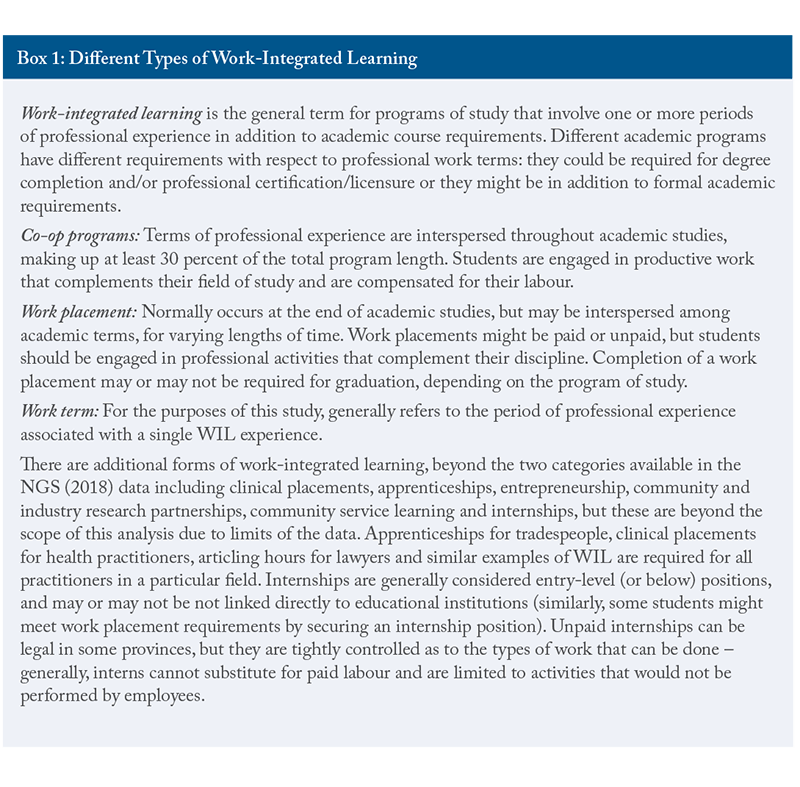
A recent analysis of the 2018 NGS shows that both university and college WIL graduates were less likely to be overqualified than non-participants, while only university graduates benefited from higher incomes (Galarneau, Kinack and Marshall 2020).
Additional studies focusing on Ontario report similar results. An analysis by Finnie and Miyairi (2017) using linked administrative student records with tax files for five Ontario post-secondary institutions found that co-op graduates had mean earnings that were consistently higher than those of non-participants, but the benefits were more pronounced at the university level. Similarly, Peters and Sattler (2014) analyzed survey information from 13 post-secondary institutions and found that university graduates who participated in WIL were less likely to be unemployed than non-participants, but there was no statistically significant difference for college graduates.
A limitation of this research is that it has not generally accounted for the non-random nature of choosing to participate in a co-op program. The characteristics of people who choose to enrol in a co-op program could differ from those of non-participants in ways that affect their long-term employment outcomes. To adjust for this non-random selection, Wyonch (2020) applies quasi-experimental techniques (propensity score matching) to measure the returns to WIL in Canada
Other research has used bespoke survey data to investigate the benefits of WIL for both students and employers in terms of performance and skill metrics. Grosjean (2000) and Sattler (2011) show that students benefit from WIL by learning discipline- or industry-specific skills, gaining information that helps form realistic career expectations and getting real-world context that can make academic studies more meaningful. Employers also benefit from developing an industry-specific workforce, the ability to bring in highly educated employees to address short-term needs and streamlined recruiting processes (Sattler and Peters 2012). In addition, Lenarcic, Biss and Pichette (2018) show that post-secondary students in Ontario believe there is a gap between the skills they are learning at university or college and the skills they will need in the workplace. In particular, the largest skills gaps are in business etiquette, leadership, teamwork and creative/innovative thinking.
Overall, there is mixed, but generally positive evidence that WIL is associated with easing graduates’ transition to the labour market, as measured by employment outcomes and the perceptions of students and employers. The following sections provide an overview of WIL in Canada, analysis of newer data that provide insights about different types of WIL (such as co-op, paid and unpaid work placements) and new estimates of the returns to WIL in Canadian postsecondary education.
A Profile of WIL in Canada
There has been significant growth in WIL participation in Canada over time: by 2015, half of all post-secondary graduates had participated in some form of WIL.
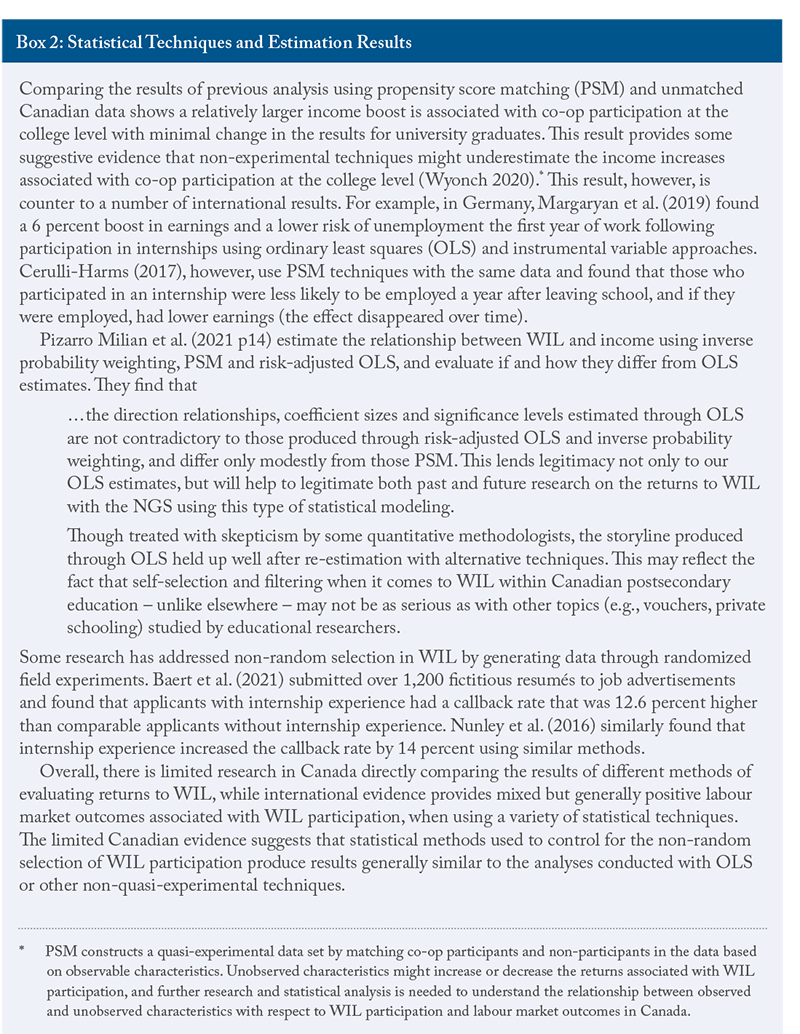
Participation varies across fields of study and levels of education (Figure 1). WIL participation is generally highest among college graduates (61 percent), followed by bachelor’s graduates (48 percent), with declining participation (and likely availability) of WIL programs as studies progress to the master’s and doctorate levels. WIL participation is highest in education (70 percent) and health and related programs (84 percent) and lowest in humanities (23 percent), physical and life sciences and technology (26 percent).
WIL participation is mandatory to graduate from many post-secondary programs: 40.5 percent of all post-secondary graduates in 2015 reported having a mandatory WIL component (81 percent of WIL participants). More than half (53.7 percent) of 2015 college graduates participated in mandatory WIL. Similarly, for the majority of students enrolled in programs in education (68.6 percent) and health and related fields (80.6 percent), WIL is a mandatory part of their education. The mandatory nature of WIL for some post-secondary programs complicates analysis of the labour market outcomes associated with participation.
Despite these positive student perceptions, there is some cause for concern in their responses as well – less than half reported being paid for their work while participating in WIL (Figure 2). Less than 10 percent of graduates of education and health programs reported being paid, meaning that three-quarters of health graduates and two-thirds of education graduates participated in unpaid WIL during their studies. Across most fields of study, a higher proportion of university graduates than college graduates reported being paid for their WIL. There are legitimate reasons for WIL experiences to be unpaid. For example, Service Learning programs, where students participate in community service integrated with classroom instruction to enrich learning and strengthen communities. As well, genuine volunteer and community services activities, activities that earn educational credits or those where a professional certification is needed to be compensated for professional work (such as law and medicine) have different labour regulations than regular employment, and generally are not required to compensate student activities with at least minimum wages.
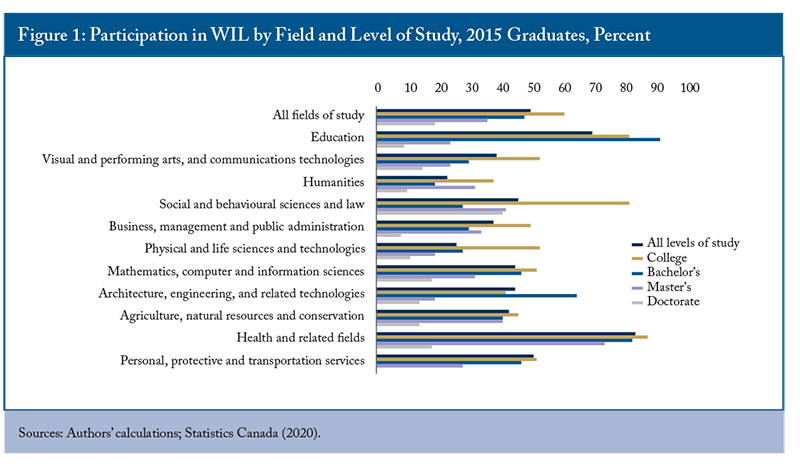
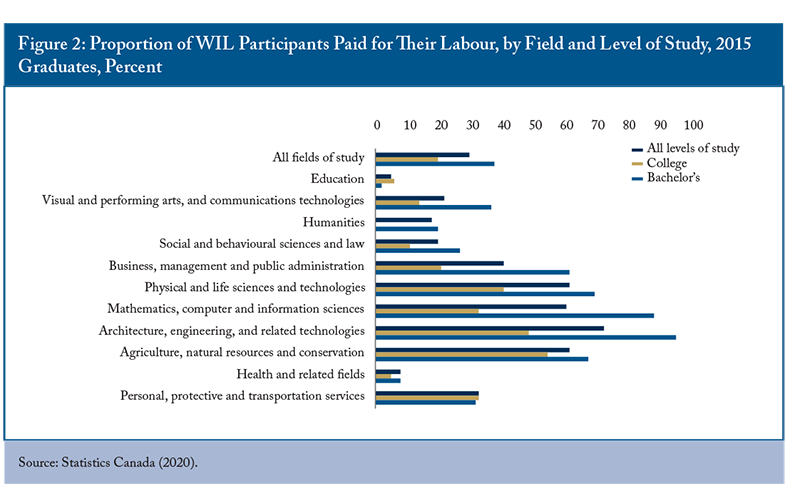
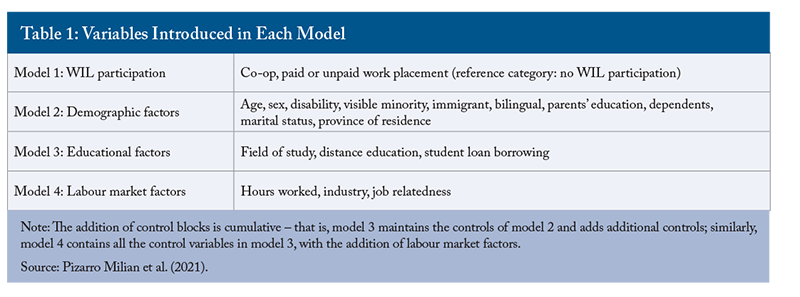
Unpaid internships can be legal in some provinces, but are generally tightly controlled as to the types of work that can be done. There are also some “volunteer” placements that suspiciously resemble employment. This opens the door to exploitative employment practices by unscrupulous employers interested in free labour. An employer might imply the prospect of a paid job in the future, and require the intern for long and underpaid hours in the meantime. Most unpaid internships are unlawful, but few victims complain for fear of personal reputational damage at the start of their
career (Whitten 2013). Although many students benefit from WIL experiences, governments and educational institutions should have safeguards in place to prevent, investigate and intervene in cases where student labour is being undercompensated to ensure that their labour rights are being upheld.
New Analysis on the Returns to WIL in Canada
To evaluate the effects of participating in a WIL program on transition to the labour market, we relied on nationally representative data from the 2018 NGS.
We used a combination of linear and logistic modelling to address a number of research questions relating WIL participation to labour market outcomes, including likelihood of employment status (full-time and permanent), job matching the level and field of education, and graduates’ employment income. Our approach involved fitting a model estimating the relationship between our dependent variables (labour market outcomes) and an indicator of WIL participation (model 1). We then added “blocks” of controls, including demographic factors (model 2), educational details (model 3) and labour market controls (model 4) to observe fluctuations in the relationship between WIL and employment outcomes (Table 1). This successive adding of blocks of controls allowed for informal inferences about the mechanisms that lead to different outcomes for WIL participants than for non-participants.
We fitted separate models for graduates from universities and colleges at the undergraduate level (including degrees, diplomas and certificates) and excluded post-graduates.
Summary of Findings
Overall, the results show that many benefits are associated with WIL and, as expected from the results of previous studies, returns to WIL participation vary by the type of institution attended, with more benefits associated with participation at the university level. Here, we present a summary of the main findings related to WIL participation and discuss some observations about the differences and nuances of the various results (See Box 3 for model and data limitations).
Table 2 shows that participation in WIL is associated with higher likelihood of having the first job after graduation be highly related to the student’s field of study across types of WIL at both the college and university levels, but the effect is larger at the university level. For university graduates, participating in any type of WIL is associated with higher income after graduation, with a larger increase associated with a co-op program, followed by paid work placements. Participating in a university co-op program is also associated with lower likelihood of unemployment and part-time employment and of being employed in a non-permanent job. Work placements, on the other hand, are not associated with higher likelihood of full-time or permanent employment at the college or university level. At the college level, co-op participation is associated with higher income following graduation, but participating in work placement is not.
Additional results of the income and job-matching models by sex show further nuance in the returns associated with participation in WIL programs (Table 3). Co-op participation is associated with larger increases in income for men than for women
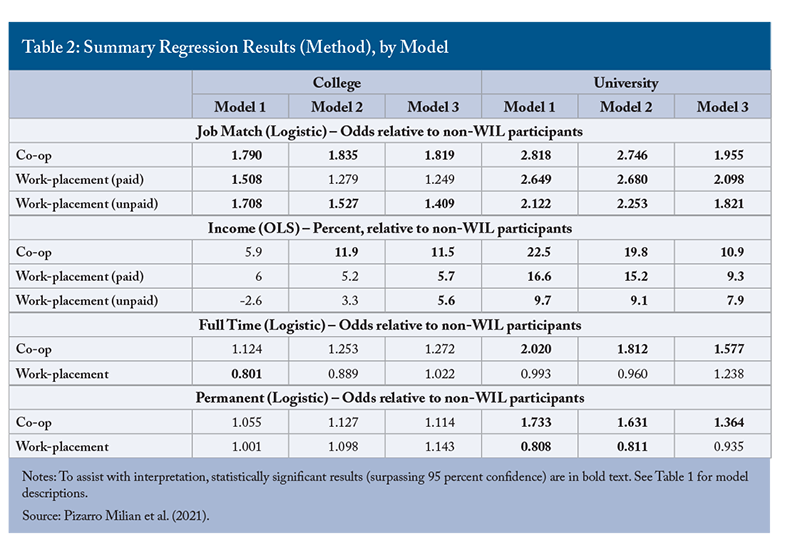
Overall, our analysis shows many benefits associated with WIL participation, but also an uneven distribution of benefits across a range of factors. In particular, more benefits are associated with co-op participation than with work placement, and those benefits are more pronounced at the university level than at the college level. Although both men and women benefit from WIL participation, women have more benefits associated with work placement than do men, and men have larger benefits associated with co-op participation. The underlying explanation of this result is beyond the scope of this analysis. However, the gap-reducing effect of adding additional blocks of controls provides suggestive evidence that field of study and post-graduation industry of employment likely contribute to the differing outcomes by sex. In the next section, we discuss some policy and program implications of these results in the context of the current labour market.
Policy Discussion and Recommendations
The results of the statistical analysis in this Commentary and previous research show that there are benefits to WIL programs, but there are also important differences between measured returns depending on the labour market outcome investigated, the type of educational institution, the demographic characteristics of graduates and the type of WIL program. Governments spend millions of dollars supporting WIL programs through tax credits, subsidies and direct funding. Insights about the different benefits to graduates in terms of their labour market outcomes are important to ensure that WIL programs are consistently refined as they are expanded and the case for government subsidization is evidence based.
Our results show that co-op programs are generally associated with more labour market benefits than are work placements. Co-op programs tend to provide more extensive work experience through more work terms, and those experiences are interspersed among academic terms. Either or both of these factors might contribute to better labour market outcomes than work placements.
The results also show a difference in outcomes related to sex: participating in a co-op program is associated with larger beneficial labour market outcomes for men than for women. Conversely, participating in a work placement is associated with larger benefits for women than for men, particularly at the college level. These results are compatible with other research showing that the returns associated with WIL participation vary with demographic characteristics (sex, visible minority status and immigration status) (Wyonch 2020). So far, there has been little research into the reasons underlying the differences in outcomes associated with WIL participation, which could be a promising avenue for further study. Similarly, further analysis of differences in outcomes based on region, fields of study and demographic characteristics could illuminate mechanisms that contribute to differing outcomes. In addition, given the limited timeframe of surveys following graduation, we cannot determine if these differences persist over the long term. The differences in returns to WIL participation have implications for wage gaps in the broader economy. Since men receive more benefits from co-op participation, co-op programs potentially could increase wage gaps between men and women in the labour market if both sexes are equally likely to participate.
There are benefits to participating in WIL regardless of demographic characteristics, particularly at the university level and with respect to job matching. Co-ops appear to be generally more beneficial than work placements. This suggests that some features of co-op programs that are not present in work placements might significantly impact the transition to the labour market. Since work terms are interspersed throughout education, students can either develop more in-depth experience with a particular employer or discipline or they might try a wide breadth of possible employment options related to their field of study. The labour market information gained might also affect students’ choices of elective courses or otherwise make them more strategic or employment focused about their education. It could also be that the limited exposure to the job market afforded by work placements does not yield work experience for participants that is significantly different from that of those who enter the labour market directly following graduation.
Given that WIL programs are generally found to have benefits for students, it is unsurprising that they are well supported by governments. In 2016, the federal government dedicated $73 million over four years to the Post-Secondary Industry Partnership and Co-operative Placement Initiative, with the goal of increasing WIL opportunities in science, technology, engineering, mathematics and business fields. In 2019, the federal government dedicated $631.2 million over five years to the Student Work Placement Program
Current government policies surrounding WIL generally support different forms of work placements and put priority on particular disciplines (skilled trades, STEM and business, in particular) and increasing representation for underrepresented groups. Through the Student Work Placement program, employers can receive 50 percent of wages up to $5,000 for every student hired through the program and 70 percent up to $7,000 for students in their first year or from an underrepresented group. A student work placement can include mentorship programs, co-op placements, practicums and internships. The Innovative Work-Integrated Learning Initiative focuses on providing opportunities that are short and intensive in nature and use technology, including short-term work placements, virtual internships, hackathons, business cases and classroom projects to help the community. There are also provincial policies supporting WIL such as the Co-operative Education Tax Credit in Ontario, which allows employers to claim 25 to 30 percent of eligible expenditures (up to $3,000) for each student in a work placement.
Some notable observations from WIL survey data should be considered in refining WIL support policies. Half of all post-secondary graduates had access to a WIL opportunity, yet nationally representative data that detail types of WIL experiences and lengths of work terms are limited, which in turn restricts the level of analysis that can be performed. Some of the funding that governments are investing in the development of WIL should be directed to collecting data that include more information and larger sample sizes to aid researchers and policymakers in program evaluation. There is a complex relationship between institutional and disciplinary practices, providing appropriate subsidization to encourage business participation and having many students require WIL placements to complete their education. In some fields, such as physical and life sciences and mathematics, and computer and information technologies, more than half of WIL participation is voluntary and higher proportions of students are paid for their work. In others, such as health and education, the vast majority of students participate in mandatory WIL, but very few of them are paid. More granular and representative data could illuminate the interactions of government policy with these labour market and educational factors.
Opportunities exist to refine government policies supporting WIL to be more focused on outcomes. For example, a higher proportion of domestic students participate in WIL than immigrant graduates, despite research showing that immigrants with Canadian labour market experience during their studies are more likely to stay in Canada and that participation in a university WIL program is associated with significantly higher income after graduation (Crossman et al. 2022; Wyonch 2020). This suggests that there are opportunities to adjust government policies to subsidize improved labour market outcomes more efficiently for post-secondary graduates by, for example, targeting the expansion of co-op programs at the university level and encouraging participation of international students.
Policies supporting and governing WIL programs in Canada are complex and include taxation, subsidization and regulation. This means there are many options for adjusting, improving and further optimizing WIL policies. For example, since co-op programs, with interspersed work and academic terms, are associated with more benefits than are work placements at the end of studies, the subsidy for employing a student during a work term could be higher if the student is returning to studies following the term of employment or is currently enrolled in a co-op program. This could encourage more participation by employers in co-op programs.
In the current labour market context of low unemployment and high job vacancy rates, ensuring a smooth transition to the labour market for new graduates is directly linked to broader economic success. New graduates might not have difficulty finding employment when there is a labour shortage, but those who participate in WIL programs, particularly co-ops at the university level, are more likely to get a job that is well matched to their education and, in some cases, to have a higher income and be more likely to be employed in a permanent, full-time position. Since significant government spending is associated with supporting WIL programs, insights about the factors affecting graduates’ success should inform strategic improvements to programs and be used to direct public policy efforts strategically to improve graduates’ outcomes.
Conclusion
Successful transition from education to the labour market sets people up for careers in their chosen field, with better chances of secure, full-time employment at livable wages, with additional benefits such as supplementary health insurance and paid vacation time. Work-integrated learning programs help prepare post-secondary graduates for transition to the labour market and are associated with improved labour market outcomes across a number of metrics. More benefits, however, are associated with co-op programs and the university level of education. The results of our analysis echo those from previous studies that show WIL programs are beneficial, but also that important distinctions underlie the overall results. New data and analysis allow for a deeper understanding of the outcomes associated with different types of WIL and should inform future program design and expansion efforts. They should also help students form realistic expectations about their eventual labour market outcomes when deciding which programs, fields of study and type of institution they should enrol in for post-secondary studies.
REFERENCES
Baert, B.S., B. Neyt, T. Siedler, I. Tobback, and D. Verhaest. 2021. “Student Internships and Employment Opportunities after Graduation: A Field Experiment.” Economics of Education Review 83 (August): 102141. https://doi.org/10.1016/j.econedurev.2021.102141.
CEWIL Canada. “What is Work-Integrated Learning (WIL)”? https://cewilcanada.ca/CEWIL/CEWIL/About-Us/Work-Integrated-Learning.aspx?hkey=ed772be2-00d0-46cd-a5b8-873000a18b41
Cerulli-Harms, A. 2017. “Generation internship: The impact of internships on early labour market performance.” IZA Discussion Papers, No. 11163, Institute of Labor Economics. https://www.econstor.eu/bitstream/10419/174073/1/dp11163.pdf
Crossman, E., Y. Choi, Y. Lu, and F. Hou. 2022. “International Students as a Source of Labour Supply: A Summary of Recent Trends.” Economic and Social Reports. Ottawa: Statistics Canada, March 23. https://www150.statcan.gc.ca/n1/pub/36-28-0001/2022003/article/00001-eng.htm
Drewery, D., and J. Pretti. 2019. The Practice of Co-op and Work-Integrated Learning in the Canadian Context. https://cewilcanada.ca/common/Uploaded%20files/Public%20Resources/research/The%20Practice%20of%20Co-op%20and%20Work-Integrated%20Learning%20in%20the%20Canadian%20Context%20(2).pdf.
Finnie, R., and M. Miyairi. 2017. “The earnings outcomes of post-secondary co-op graduates: Evidence from tax-linked administrative data.” Education Policy Research Initiative, University of Ottawa. https://ruor.uottawa.ca/bitstream/10393/42160/1/Earnings of Post- secondary Co-op Graduates - Final Report.pdf
Finnie, R., Miyairi, M., Dubois, M., Bonen, T. and Amery, B. 2019. “How much do they make? New evidence on the early career earnings of Canadian post-secondary education graduates by credential and field of study.” Labour Market Information Council.
Frenette, M. 2004. “The Overqualified Canadian Graduate: The Role of the Academic Program in the Incidence, Persistence, and Economic Returns to Overqualification.” Economics of Education Review 23 (1): 29–45. https://doi.org/10.1016/S0272-7757(03)00043-8.
Galarneau, D., M. Kinack, and G. Marshall. 2020. “Work-Integrated Learning during Postsecondary Studies, 2015 Graduates.” Ottawa: Statistics Canada. https://epe.lac-bac.gc.ca/100/201/301/weekly_acquisitions_list-ef/2020/20-22/publications.gc.ca/collections/collection_2020/statcan/75-006-x/75-006-2020-3-eng.pdf.
Grosjean, G. 2000. “Doing Coop: Student Perceptions of Learning and Work.” PhD diss., University of British Columbia.
Lenarcic Biss, Danielle, and Jackie Pichette. 2018. “Minding the Gap? Ontario Postsecondary Students’ Perceptions on the State of Their Skills.” Toronto: Higher Education Quality Council of Ontario. Available online at http://www.heqco.ca/SiteCollectionDocuments/Formatted_%20Student%20Skills%20Survey_FINAL.pdf.
Margaryan, S., N. Saniter, M. Schumann, and T. Siedler. 2019. “Do Internships Pay Off? The Effects of Student Internships on Earnings.” IZA Discussion Paper 12478. Bonn: Institute of Labor Economics. https://ftp.iza.org/dp12478.pdf.
Nunley, J.M., A. Pugh, N. Romero, and R.A. Seals. 2016. “College Major, Internship Experience, and Employment Opportunities: Estimates from a Résumé Audit.” Labour Economics 38 (January): 37–46. https://doi.org/10.1016/j.labeco.2015.11.002.
Peters, J., and P. Sattler. 2014. “Work-integrated learning in Ontario’s postsecondary sector: The pathways of recent college and university graduates.” HEQCO. https://heqco.ca/wp-content/uploads/2020/03/WIL_Grad-Follow-up-ENG.pdf
Pizarro Milian, R., B. Seward, D. Walters, and R. Wyonch. 2021. Work Integrated Learning: Does It Provide a Labour Market Advantage? Evidence from the 2018 National Graduate Survey. Toronto: FutureSkills Research Lab.
Sattler, P. 2011. Work-Integrated Learning in Ontario’s Postsecondary Sector. Toronto: Higher Education Quality Council of Ontario.
Sattler, P., and J. Peters. 2012. Work-Integrated Learning and Postsecondary Graduates: The Perspective of Ontario Employers. Toronto: Higher Education Quality Council of Ontario. http://www.heqco.ca/SiteCollectionDocuments/WIL%20Employer%20Survey%20ENG.pdf.
Sattler, P., and J. Peters. 2013. Work-Integrated Learning in Ontario’s Postsecondary Sector: The Experience of Ontario Graduates. Toronto: Higher Education Quality Council of Ontario. https://heqco.ca/pub/work-integrated-learning-in-ontarios-postsecondary-sector-the-experience-of-ontario-graduates/.
Statistics Canada. 2020. “Work-integrated learning participation of postsecondary graduates, by province of residence at interview, level of study, field of study and sex.” Table 37-10-0187-01. https://www150.statcan.gc.ca/t1/tbl1/en/tv.action?pid=3710018701.
Statistics Canada. 2022a. Table 14-10-0325-01 Job vacancies, payroll employees, job vacancy rate, and average offered hourly wage by provinces and territories, quarterly, unadjusted for seasonality.https://www150.statcan.gc.ca/t1/tbl1/en/tv.action?pid=1410032501
Statistics Canada. 2022b. Table 37-10-0086-01 Postsecondary enrolments, by status of student in Canada, country of citizenship and gender.
Statistics Canada. 2023. Labour Force Survey, December 2022. The Daily. Available at https://www150.statcan.gc.ca/n1/daily-quotidien/230106/dq230106a-eng.htm
Wall, K. 2020. “COVID-19 Pandemic: Impacts on the Work Placements of Postsecondary Students in Canada.” Ottawa: Statistics Canada. https://www150.statcan.gc.ca/n1/en/pub/45-28-0001/2020001/article/00022-eng.pdf?st=wShuVLBT.
Walters, D., and Zarifa, D. 2008. “Earnings and employment outcomes for male and female postsecondary graduates of coop and non‐coop programmes.” Journal of Vocational Education & Training, 60(4), 377–399. https://doi.org/10.1080/13636820802591863
Whitten, David. 2013. “Unpaid Internships a Costly Risk.” Canadian Employment Law Today, May 29.Available online at https://www.hrreporter.com/employment-law/news/unpaid-internships-a-costly-risk/318687
Wyonch, R. 2020. Work-Ready Graduates: The Role of Co-op Programs in Labour Market Success. Commentary 562. Toronto: C.D. Howe Institute. https://www.cdhowe.org/sites/default/files/attachments/research_papers/mixed/Commentary%20562.pdf.







